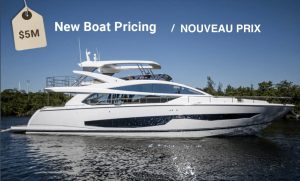Boat dry weights.
For some time now, most manufacturers no longer give the empty weight of the boats they build.
Why?
Because they want to avoid a bad comparison with a competing manufacturer who publishes it (dry weight) since the data is rather favorable.
Is it important to know…
Yes, of course, it’s very important. Dry weight gives a very good idea of the quality of the construction, the quality of the structure, which translates into greater comfort in rougher waters.
The empty weight excludes all liquid tanks and, of course, all possible options such as rigid roofs. The empty weight is the weight of the boat for the basic model without options.
To those who will tell you that the boat is light because of the use of carbon fiber or Kevlar, yes, it’s true, but check your claims before concluding. Some mention carbon fiber or Kevlar, but if this is the case, it must be explicitly stated by the manufacturer. Some manufacturers use carbon for the out-of-water parts, such as the rigid roofs, and the mast for the radar, to reduce weight and achieve a better center of gravity, for example.
More on this subject later in this text
It’s the fluids that increase the weight of a boat, and of course the hardtop and certain other systems.
Nowadays, manufacturers sometimes indicate LIGHT WEIGHT or nothing at all, so we have to conclude that it’s most likely with fairly significant levels of liquids for LIGHT WEIGHT, or the maximum weight with all liquids and options in the situation where you only see the DISPLACEMENT mention.
What you need to know…
1 liter of water weighs 1 kg and oil is slightly lighter than water, but this is negligible.
So 1 kg = 2.2 lbs.
1 us gal = 8.4 lbs
So a boat with a 600 US gal. fuel tank plus a 200 US gal. drinking water tank adds more than 6700 lbs in pounds to the weight of the boat with full tanks.
It’s difficult to verify other weights, such as a hardtop on a 60-foot yacht, the presence or absence of a crane or hydraulic system, the addition of teak everywhere…
There’s also the addition of a Seakeeper in the engine room, for example, or a water maker. In short, many components can change the weight of a boat. Also, is the anchor counted, or the chain? In short, check the manufacturer’s technical data sheet, and don’t hesitate to ask questions.
You should also consider the weight of the engine(s) and propulsion system.
Measuring DRY WEIGHT was therefore an excellent source of information for making comparisons.
Sometimes the differences are major.
I can’t resist quoting this example:
Prestige 520 Fly dry weight: 30,000 lbs (approx)
Sunseeker 52 FlY dry weight: 60,000 lbs (approx)
Viking 52 dry weight: 67,000 lbs (approx)
Yet these are three 52-foot yachts.
 Prestige 520 Fly
Prestige 520 Fly
 Sunseeker Manhattan 52
Sunseeker Manhattan 52
 Viking 52
Viking 52
But the boat’s rather light weight doesn’t necessarily make it any less attractive. I’d say it depends on the intended sailing areas and, above all, the sailing conditions.
In calm seas or water, with almost no waves, you’ll appreciate almost any boat.
But in rough water with unpleasant waves, that’s when the yacht’s robustness counts.
In rough, even very rough seas, I prefer a yacht with a reputation for ruggedness, a real TANK of the seas…(like a Viking or Riviera) or for an express, a Sunseeker or a Pershing of 62 ft or more, but these are personal choices.
 Pershing 62
Pershing 62
So, when you want to compare boats, use the DRY WEIGHT measurement.
Keep in mind that if the boat’s description is DISPLACEMENT only, it’s probably the full weight.
New materials.
There’s KEVLAR, of course, which reduces the weight of fiberglass by almost half. The same goes for carbon fiber.
But these two lightweight materials have acoustic effects that are not always pleasant. For example, a carbon hull reproduces noise quite significantly, making the acoustic comfort of rooms on the lower deck very uncomfortable.
But there’s no problem using these components if they’re used out of the water, as in the case of the hardtop, super structure and transom, for example. But carbon fiber is about 5 times more expensive than fiberglass. What’s more, it’s more fragile than fiberglass in the event of a collision.


We’ll have to look at the advantages in terms of weight versus cost. Italian manufacturer Azimut is the first to use carbon on several models in its range.
Here’s the Azimut S7 and the carbon fiber gaps:
The use of components that reduce the weight of the boat in its upper section brings definite advantages to the boat.
A low center of gravity is one of the conditions for a boat to be classified A (CE rating). But there are many other criteria for assessing the characteristics of a boat, see this link. A B-rated yacht should not be considered as a lesser quality yacht. You need to look at all the criteria.
In brief…
Compare the technical data sheets and don’t hesitate to ask questions if the salesperson tells you: these are top-of-the-range materials, what does that mean!!!!
Always use GOOGLE to search for the manufacturer’s name and model, followed by the words DRY WEIGHT. Even if dry weight is indicated, do a lot of additional research, as sometimes the information is contradictory.
Ideally, consult an experienced broker to avoid unpleasant surprises.
The brokers at Ita Yachts Canada and its ProprioBateau division are at your disposal.
DISCLAIMER
The article presented on this page is for information purposes only. This information is provided as editorial (i.e. opinion). The information presented in this article is presented in good faith and, while believed to be correct, is not guaranteed. Ita Yachts Canada does not warrant or assume any legal liability or responsibility for the accuracy, completeness or usefulness of the information and/or images displayed, as they do not suggest anything in relation to this article, indeed no association can be made with respect to the images and the article. All information in this article is subject to change without notice and is without warranty. It is the reader’s responsibility to verify the descriptions and statements contained in this article. The brokers at Ita Yachts Canada assume no responsibility for any conclusions the reader may draw. The purpose of this article is to promote boating in all its forms. It gives one point of view among many. Any reproduction of this article is prohibited.
Views: 80







